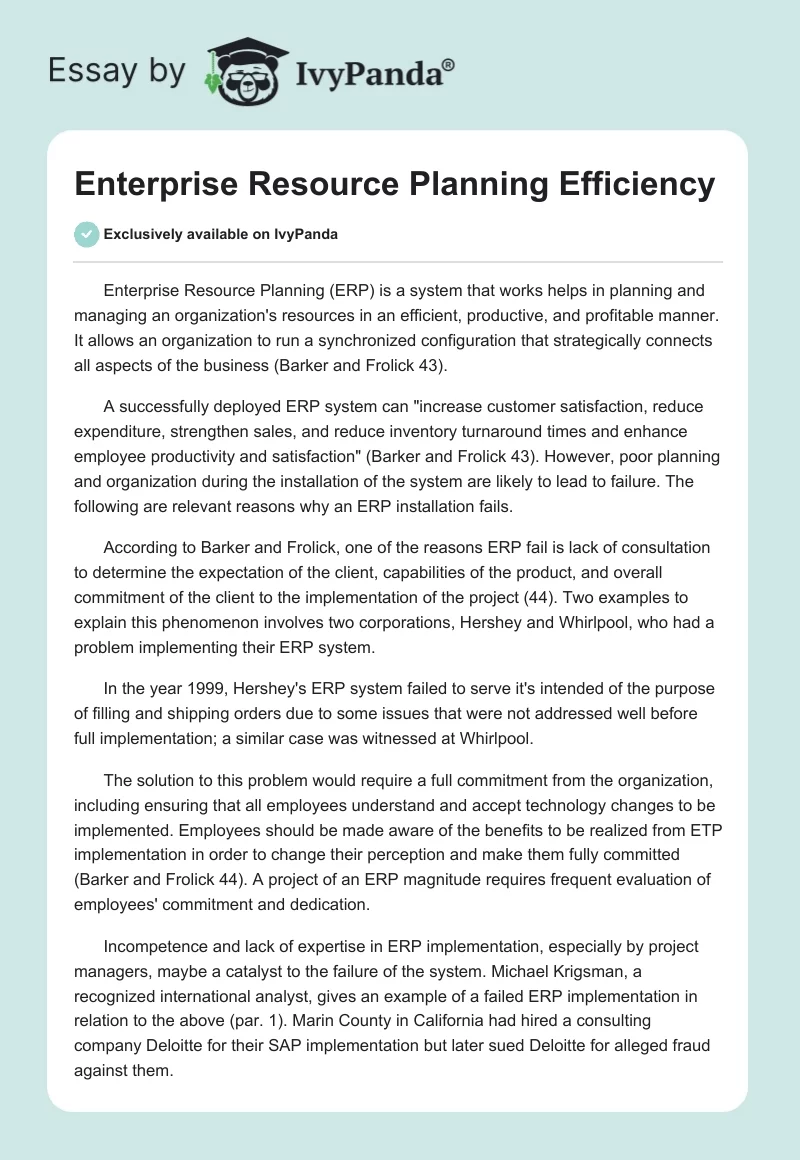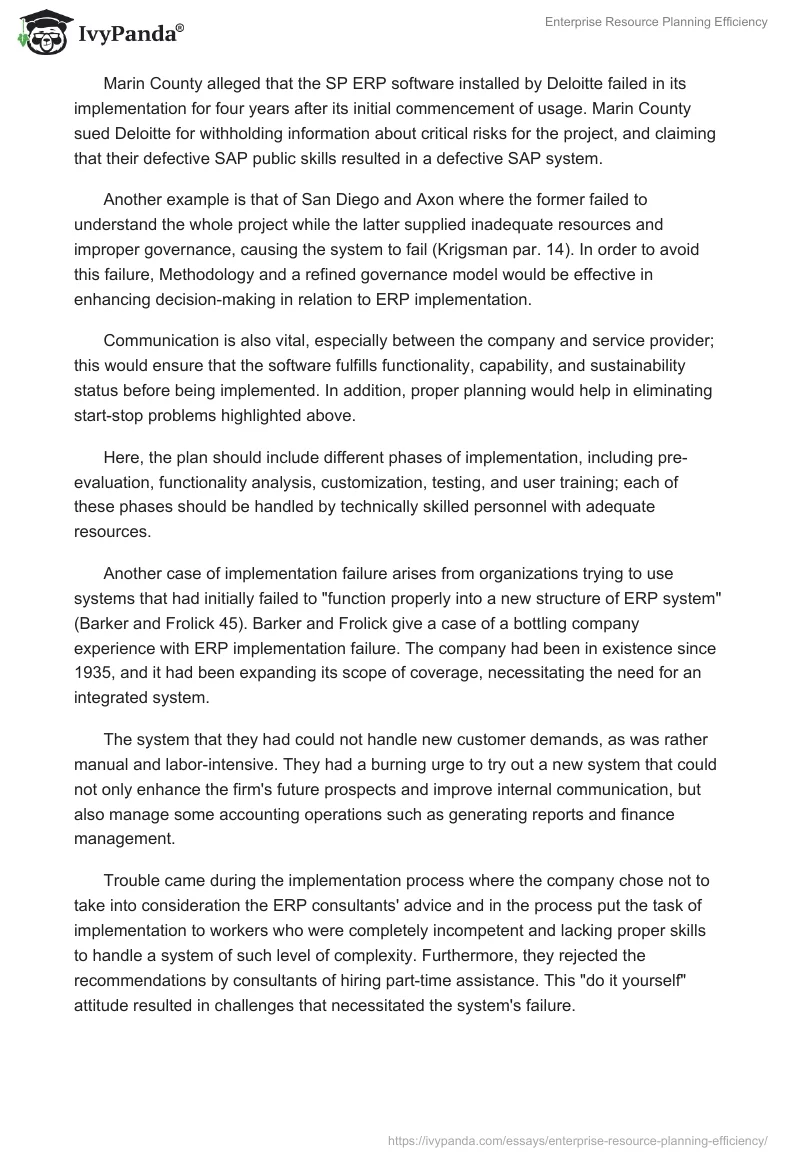Enterprise Resource Planning (ERP) is a system that works helps in planning and managing an organization’s resources in an efficient, productive, and profitable manner. It allows an organization to run a synchronized configuration that strategically connects all aspects of the business (Barker and Frolick 43).
A successfully deployed ERP system can “increase customer satisfaction, reduce expenditure, strengthen sales, and reduce inventory turnaround times and enhance employee productivity and satisfaction” (Barker and Frolick 43). However, poor planning and organization during the installation of the system are likely to lead to failure. The following are relevant reasons why an ERP installation fails.
According to Barker and Frolick, one of the reasons ERP fail is lack of consultation to determine the expectation of the client, capabilities of the product, and overall commitment of the client to the implementation of the project (44). Two examples to explain this phenomenon involves two corporations, Hershey and Whirlpool, who had a problem implementing their ERP system.
In the year 1999, Hershey’s ERP system failed to serve it’s intended of the purpose of filling and shipping orders due to some issues that were not addressed well before full implementation; a similar case was witnessed at Whirlpool.
The solution to this problem would require a full commitment from the organization, including ensuring that all employees understand and accept technology changes to be implemented. Employees should be made aware of the benefits to be realized from ETP implementation in order to change their perception and make them fully committed (Barker and Frolick 44). A project of an ERP magnitude requires frequent evaluation of employees’ commitment and dedication.
Incompetence and lack of expertise in ERP implementation, especially by project managers, maybe a catalyst to the failure of the system. Michael Krigsman, a recognized international analyst, gives an example of a failed ERP implementation in relation to the above (par. 1). Marin County in California had hired a consulting company Deloitte for their SAP implementation but later sued Deloitte for alleged fraud against them.
Marin County alleged that the SP ERP software installed by Deloitte failed in its implementation for four years after its initial commencement of usage. Marin County sued Deloitte for withholding information about critical risks for the project, and claiming that their defective SAP public skills resulted in a defective SAP system.
Another example is that of San Diego and Axon where the former failed to understand the whole project while the latter supplied inadequate resources and improper governance, causing the system to fail (Krigsman par. 14). In order to avoid this failure, Methodology and a refined governance model would be effective in enhancing decision-making in relation to ERP implementation.
Communication is also vital, especially between the company and service provider; this would ensure that the software fulfills functionality, capability, and sustainability status before being implemented. In addition, proper planning would help in eliminating start-stop problems highlighted above.
Here, the plan should include different phases of implementation, including pre-evaluation, functionality analysis, customization, testing, and user training; each of these phases should be handled by technically skilled personnel with adequate resources.
Another case of implementation failure arises from organizations trying to use systems that had initially failed to “function properly into a new structure of ERP system” (Barker and Frolick 45). Barker and Frolick give a case of a bottling company experience with ERP implementation failure. The company had been in existence since 1935, and it had been expanding its scope of coverage, necessitating the need for an integrated system.
The system that they had could not handle new customer demands, as was rather manual and labor-intensive. They had a burning urge to try out a new system that could not only enhance the firm’s future prospects and improve internal communication, but also manage some accounting operations such as generating reports and finance management.
Trouble came during the implementation process where the company chose not to take into consideration the ERP consultants’ advice and in the process put the task of implementation to workers who were completely incompetent and lacking proper skills to handle a system of such level of complexity. Furthermore, they rejected the recommendations by consultants of hiring part-time assistance. This “do it yourself” attitude resulted in challenges that necessitated the system’s failure.
Another example is that of Lumber Liquidators whose ERP system filed due to the failure of employees to integrate into the new system and internal problems in the new system (Kanaracus par. 1).
To avoid this failure, organizations would require choosing a proper project team, careful planning, and consultation throughout the implementation period in order to boost the success of the ERP system (Barker and Frolick 47). The organization should take measures such as training of personnel, good communication, and consistent management cooperation.
ERP system may also fail due to the integration of the wrong system or inadequate capability of the integrator. An example involves the case of California nonprofit against Lawson Software Company, where the former accused the latter of failing to dedicate resources to the project and Lawson did not have installers available to load the software on PHFE’s equipment” (Kanaracus par. 6).
Another example that illustrates the reason for ERP implementation failure is the case of SAP – an ERP software vendor and its client, the Waste Management Company located in Harris County in the state of Texas, U.S. According to Kanaracus, Waste Management requested for an ERP software package that could meet its daily running of business without it has large amounts of custom development (par. 2).
The system failed due to implementation of wrong software. SAP’s technical team later recommended delivery of a new version of the software, which was a complete improvement to the earlier version (Kanaracus par. 5). Therefore, the solution to this problem is to carry out due diligence before procuring a system. In addition, the organization should choose the right ERP software that would be compatible with business strategy in order to enhance competitiveness.
Another reason that leads to ERP failure is the tendency of vendors and customers to delegate the whole implementation process to the integrator and then to hold him accountable for its failure. In Michael Krigsman’s view, both the customer and the vendor contribute to the failure or success of ERP project, and as such, they should jointly take responsibility of the EPR implementation process (par. 11).
Poor communication between the customer and the vendor concerning the deadline for delivery of the software also plays an important role in the failure of ERP projects. An example related to this is the case of EDS and UK-based BSkyB-consulting Company. EDS lost a considerable amount of 300 million dollars due to the wrong information it had received about the timeframe for completion of an ERP project.
Unfortunately, EDS’ management failed to do proper analysis to confirm the amount of time BSkyB would deliver the software (Krigsman par.14). The solution to this would be full participation of the company and supplier of the EPR in the implementation of the software rather than delegating everything to the integrator.
The vendors should make sure that they complete the task, and the customer must enhance the delivery of the result. They should learn to control the conversation with their integrators and lead from the start (Krigsman par. 11). Proper training of the procurement team, as well as the manager, would be important in order to enhance effective communication of ERP specifications to the vendor and integrator
In conclusion, the ERP system is very important in organizations, especially in the management of resources. Therefore, it is important to establish proper implementation policies and procedures in order to avert any cases of failure. There are many reasons why ERP systems fail, including lack of commitment, poor planning, and poor communication, among others.
Therefore, organizations must adopt sound strategies to avoid failure of ERP, including enhancing total commitment, proper communication, proper planning, and right ERP software selection. In addition, organizations would enhance successful ERP implementation through leadership support, competent implementation team, clear implementation schedule, proper change management techniques, and extensive training.
However, customers and the environment the systems are to be introduced into greatly influence and determine the nature of the outcome of the ERP project. All in all, proper communication between the vendor, customer, and system implementation team is important for the success of the ERP system.
Works Cited
Barker, Traci and Mark Frolick. “Information system management fall- ERP- Implementation Failure: A Case study.” Information Systems Management. 20.4 (2003): 43–49. Print.
Kanaracus, Chris. SAP, Waste Management settle lawsuit. 2010. Web.
Kanaracus, Chris. Nonprofit Sues Lawson Over Alleged ERP Failure. 2009. Web.
Kanaracus, Chris. ERP Woes Blamed for Lumber Company’s Bad Quarter. 2010. Web.
Krigsman, Michael. Marin County sues Deloitte: Alleges fraud on SAP project. 2010. Web.
Krigsman, Michael. San Diego fires Axon over ERP implementation problems. 2009. Web.


